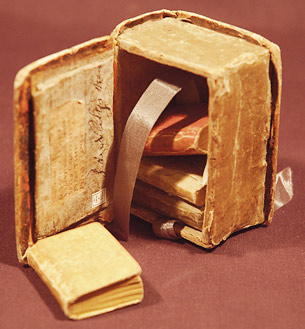2060 B.C.E.

The earliest known example of miniature writing appears on a Sumerian cuneiform clay tablet measuring 1 5/16 inches by 1 5/8 inches. (Courtesy of The Lilly Library, Indiana University, Bloomington, Indiana)
1877 C.E.
Sixty years after the publication of James Parkinson's landmark "Essay on the Shaking Palsy," French neurologist Jean-Martin Charcot first recognizes micrographia, or increasingly miniaturized handwriting, as a clinical symptom of Parkinson's disease.
1884 C.E.
The Bibliothèque Nationale in Paris becomes the first library in the world to use microfilm to condense texts.
1894 C.E.

Miniature book collector George Salomon of Paris disperses his seven-hundred-title collection, a library that reportedly "could be carried in a moderate-sized portmanteau." His spirit lives on today in the Miniature Book Society, an organization whose interests extend only to printed works three inches or smaller. (Pocket Library of Lilliputian Folio Books, London, 1801. Courtesy of The Lilly Library, Indiana University, Bloomington, Indiana)
2003 C.E.
The Guinness Book of World Records recognizes Pawan Sinha and Pamela Lipson, a husband-and-wife team of vision researchers, along with psychology professor Keith Kluender, for creating the world's smallest book. While napping during an academic conference, Sinha, a Hindu, dreamt of inscribing the entire Bhagavad Gita on a grain of rice. When he awoke, he realized the Gita was too short to pose much of a challenge and instead conspired with his wife (a Jew) to develop software to print the 180,568-word New Testament in twenty-four-karat gold on a silicon chip. Each letter is the size of a red blood cell [Check this out!] The entire book fits on a five-square-millimeter tablet.

No comments:
Post a Comment